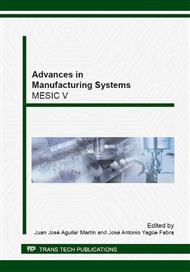[1]
Thomas, T.R., 1999. Rough Surfaces, World Scientific Publishing Company, 2nd Edition ISBN: 978-1-86094-100-9.
Google Scholar
[2]
Li, T., 2011. Softgauges for surface texture, PhD thesis, University of Huddersfield.
Google Scholar
[3]
ISO 25178-6: 2010, Geometric specification of products (GPS) Finishing Quality: Areas. Part 6: Methods classification for Finishing Quality Measurement.
Google Scholar
[4]
National Institute of Standards and Technology. Mechanical Metrology Division. Reference Software for 3D Surface Analysis 2013. http: /physics. nist. gov/VSC/jsp/index. jsp.
Google Scholar
[5]
Greenwood ,J.A., Williamson, J. B. P., 1966. Contact of Nominally Flat Surfaces, Proceedings of the Royal Society of London. Series A, Mathematical and Physical Sciences, Vol 295, 1442 pp.300-319.
DOI: 10.1098/rspa.1966.0242
Google Scholar
[6]
Sahoo, P., Ghosh, N., 2007. Finite Element Contact Analysis of Fractal Surfaces, Journal of Physics D: Applied Physics, Vol. 40, pp.4245-4252.
DOI: 10.1088/0022-3727/40/14/021
Google Scholar
[7]
Popov, V.L., Filippov, A.E., 2010. Force of friction between fractal rough surface and elastomer, Technical Physics Letters , vol 36, num 6 pp.525-527.
DOI: 10.1134/s1063785010060118
Google Scholar
[8]
Gao ,J., Fu, X., 2012. Fractal Model for the Effective Thermal Conductivity of Goose Down Assembly, Advanced Science Letters, vol 10, num 1 pp.666-668.
DOI: 10.1166/asl.2012.3367
Google Scholar
[9]
Torkhov, N.A., Bozhkov, V.G., 2009. Fractal character of the distribution of surface potential irregularities in epitaxial n-GaAs, Semiconductors, vol 43, num 5, pp.551-556.
DOI: 10.1134/s1063782609050017
Google Scholar
[10]
Robbe-Valloire, F., 2001. Statistical analysis of asperities on a rough surface, Wear, Vol 249, num 5–6 401-408.
DOI: 10.1016/s0043-1648(01)00548-8
Google Scholar
[11]
Antoniadis, A., Savakis, C., Bilalis, N., Balouktsis, A., 2003. Prediction of Surface Topomorphy and Roughness in Ball-End Milling, Int J of Advanced Manufacturing Technology, vol 21, num 12, pp.965-971.
DOI: 10.1007/s00170-002-1418-8
Google Scholar
[12]
Wu, J.J., 2000. Simulation of rough surfaces with FFT, Tribology International, vol 33, num 1, pp.47-58.
Google Scholar
[13]
Nemoto, K., Yanagi, K., Aketagawa, M., Yoshida, I., Uchidate, M., Miyaguchi, T., Maruyama, H., 2009. Development of a roughness measurement standard with irregular surface topography for improving 3D surface texture measurement, Meas Sci Tech, vol 20 num 8. pp.1-7.
DOI: 10.1088/0957-0233/20/8/084023
Google Scholar


